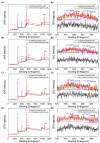Cr(VI) Removal by Recombinant Escherichia coli Harboring the Main Functional Genes of Sporosarcina saromensis M52
- PMID: 35308358
- PMCID: PMC8927625
- DOI: 10.3389/fmicb.2022.820657
Cr(VI) Removal by Recombinant Escherichia coli Harboring the Main Functional Genes of Sporosarcina saromensis M52
Abstract
Hexavalent chromium [Cr(VI)], a recognized heavy metal pollutant, has attracted much attention because of its negative impact on the ecological environment and human health. A chromium-resistant strain, Sporosarcina saromensis M52, was discovered, and the functional genes orf2987, orf3015, orf0415, and orf3237 were identified in the strain by genomics. With the advancement of DNA recombination and gene-splicing technology, genetic engineering technology was used to produce recombinant strains 2987, 3015, 0415, and 3237. The study revealed Cr(VI) tolerance in the order of M52 ≈ 2987 > 3015 ≈ 0415 > 3237 and reduction abilities in the order of M52 ≈ 2987 > 3015 > 0415 ≈ 3237. SEM-EDS, XRD, FT-IR and XPS were utilized to examine the surface structure of the recombinant strains and analyze the surface components and main functional groups. A comprehensive review of the recombinant strains' capacity to tolerate and reduce Cr(VI) revealed that orf2987 and orf0415 were the main functional genes in Sporosarcina saromensis M52, which may play a key role in removing Cr(VI) and protecting the strain, respectively. The optimum pH for recombinant strains 2987 and 0415 was 7.5-8.5, and the optimum temperature was 37°C. Cu2+ had the greatest promotional effect when Cr(VI) was removed by them, while SDS had an inhibitory effect. This research provided the foundation for further study into the mechanism of Cr(VI) reduction in Sporosarcina saromensis M52, as well as a theoretical basis for the development of effective engineered strains to repair Cr(VI) contamination.
Keywords: Cr(VI) reduction; Sporosarcina saromensis M52; bioremediation; hexavalent chromium; recombinant bacteria.
Copyright © 2022 An, Zhang, Guo, Wang, Xu, Fan, Li, Zhang, Li, Chen, You and Zhao.
Conflict of interest statement
The authors declare that the research was conducted in the absence of any commercial or financial relationships that could be construed as a potential conflict of interest.
Figures








References
-
- Abe F., Miura T., Nagahama T., Inoue A., Usami R., Horikoshi K. (2001). Isolation of a highly copper-tolerant yeast, Cryptococcus sp., from the Japan trench and the induction of superoxide dismutase activity by Cu2+. Biotechnol. Lett. 23, 2027–2034. doi: 10.1023/A:1013739232093 - DOI
-
- Agrawal A., Kumar V., Pandey B. D. (2006). Remediation options for the treatment of electroplating and leather tanning effluent containing chromium—a review. Miner. Process. Extr. Metall. Rev. 27, 99–130. doi: 10.1080/08827500600563319 - DOI
LinkOut - more resources
Full Text Sources

